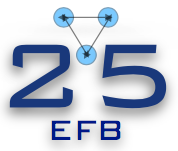Speaker
Description
A trion is the bound state of an exciton with another charged carrier, which can either be an electron (X⁻ trion) or a hole (X⁺ trion). We develop the theoretical formalism and study the formation of valleytrions in transition metal dichalcogenides monolayers within the framework of a nonrelativistic potential model using the method of hyperspherical harmonics (HH) in four-dimensional space. There are intravalley and intervalley X⁻ trions, while due to the Pauli exclusion principle, the X⁺ trion can only exist in the intervalley configuration. We solve the three-body Schrödinger equations with the Keldysh potential by expanding the wave functions of a trion in terms of the antisymmetrized HH. The antisymmetrization is based on the electron and hole spins and valley indexes. We present and discuss the origin of the binding energy difference between X⁻ and X⁺ trions. Results of numerical calculations for the ground state energies are in good agreement with similar calculations for the Keldysh potential and in fair agreement with the reported experimental measurements for trions binding energies.
It is considered a long-range approximation when the Keldysh potential can be approximated by the Coulomb potential and a short-range limit when this potential is approximated by the logarithmic potential. In a diagonal approximation in both limits, the system of differential equations for the hyperradial functions is decoupled. Our approach yields the analytical solution for binding energies of trions in diagonal approximation for these two limiting cases - the Coulomb and logarithmic potentials. We obtained exact analytical expressions for energy eigenvalues and eigenfunctions for X⁻ and X⁺ trions. The corresponding energy eigenvalues can be considered as the lower and upper limits for the trions binding energies.

